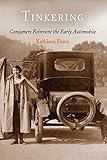Tinkering : Consumers Reinvent the Early Automobile / Kathleen Franz.
Material type: TextPublisher: Philadelphia : University of Pennsylvania Press, [2011]Copyright date: ©2005Description: 1 online resource (232 p.) : 22 illusContent type:
TextPublisher: Philadelphia : University of Pennsylvania Press, [2011]Copyright date: ©2005Description: 1 online resource (232 p.) : 22 illusContent type: - 9780812221589
- 9780812201932
- 629.222/0973
- online - DeGruyter
- Issued also in print.
| Item type | Current library | Call number | URL | Status | Notes | Barcode | |
|---|---|---|---|---|---|---|---|
 eBook
eBook
|
Biblioteca "Angelicum" Pont. Univ. S.Tommaso d'Aquino Nuvola online | online - DeGruyter (Browse shelf(Opens below)) | Online access | Not for loan (Accesso limitato) | Accesso per gli utenti autorizzati / Access for authorized users | (dgr)9780812201932 |
Browsing Biblioteca "Angelicum" Pont. Univ. S.Tommaso d'Aquino shelves, Shelving location: Nuvola online Close shelf browser (Hides shelf browser)

|

|

|

|

|

|

|
||
| online - DeGruyter The Power of Money : Coinage and Politics in the Athenian Empire / | online - DeGruyter Doctor Franklin's Medicine / | online - DeGruyter Tragicomic Redemptions : Global Economics and the Early Modern English Stage / | online - DeGruyter Tinkering : Consumers Reinvent the Early Automobile / | online - DeGruyter Character's Theater : Genre and Identity on the Eighteenth-Century English Stage / | online - DeGruyter The People of the Parish : Community Life in a Late Medieval English Diocese / | online - DeGruyter The Good Women of the Parish : Gender and Religion After the Black Death / |
Frontmatter -- Contents -- Introduction. Automobiles in the Machine Age -- 1. What Consumers Wanted -- 2. Women's Ingenuity -- 3. Consumers Become Inventors -- 4. A Tinkerer's Story -- 5. The Automotive Industry Takes the Stage -- Epilogue: Tinkering from Customizing to Car Talk -- Notes -- Index -- Acknowledgments
restricted access online access with authorization star
http://purl.org/coar/access_right/c_16ec
In the first decades after mass production, between 1913 and 1939, middle-class Americans not only bought cars but also enthusiastically redesigned them. By examining the ways Americans creatively adapted their automobiles, Tinkering takes a fresh look at automotive design from the bottom up, as a process that included manufacturers, engineers, advice experts, and consumers in various guises.Franz argues that automobile ownership opened new possibilities for ingenuity among consumers even as large corporations came to control innovation. Franz weaves together a variety of sources, from serial fiction to corporate documents, to explore tinkering as a form of authority in a culture that valued ingenuity. Women drivers represented one group of consumers who used tinkering to advance their claim to social autonomy. Some canny drivers moved beyond modifying their individual cars to become independent inventors, patenting and selling automotive accessories for the burgeoning national demand for aftermarket products. Earl S. Tupper was one such tinkerer who went on to invent Tupperware.These savvy tinkerers worked in a changing landscape of invention shaped increasingly by automotive giants. By the 1930s, Ford and General Motors worked to change the popular discourse of ingenuity and used the world's fairs of the Depression as a stage to promote a hierarchy of innovation. Franz not only demonstrates the entrepreneurial spirit of American consumers but she engages larger historical questions about gender, consumption and ingenuity while charting the impact corporate expansion on tinkering during the first half of the twentieth century.
Issued also in print.
Mode of access: Internet via World Wide Web.
In English.
Description based on online resource; title from PDF title page (publisher's Web site, viewed 24. Apr 2022)


